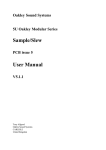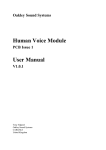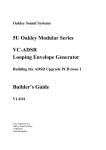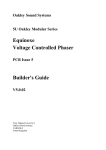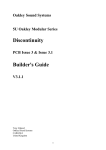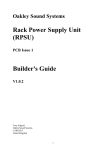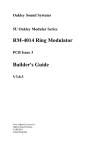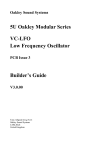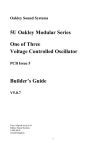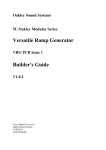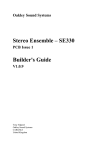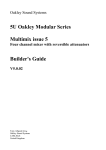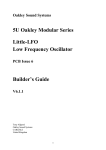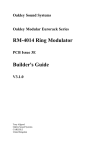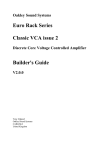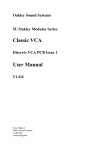Download ADSR/VCA Builder`s Guide
Transcript
Oakley Sound Systems 5U Oakley Modular Series ADSR/VCA Looping Envelope Generator PCB Issues 3 and 4 Builder’s Guide V4.0.04 Tony Allgood B.Eng Oakley Sound Systems CARLISLE United Kingdom The updated 1U wide front panel in our traditional MOTM compatible format. 2 Introduction This is the Project Builder's Guide for the issues 3 and 4 of the ADSR/VCA 5U module from Oakley Sound. This document contains a basic introduction to the board, a full parts list for the components needed to populate the boards, and a list of the various interconnections. Issue 3 and issue 4 PCBs are identical in everything but a slight change in tracking. Issue 4 boards improve grounding layout and allow the LED to be wired direct to its pad without any increased control voltage bleedthrough. The LED when fitted to an issue 3 board should be wired as detailed in the relevant section of this Builder's Guide. For the User Manual, which contains an overview of the operation of the unit and all the calibration procedures, please visit the main project webpage at: http://www.oakleysound.com/adsr.htm For general information regarding where to get parts and suggested part numbers please see our useful Parts Guide at the project webpage or http://www.oakleysound.com/parts.pdf. For general information on how to build our modules, including circuit board population, mounting front panel components and making up board interconnects please see our generic Construction Guide at the project webpage or http://www.oakleysound.com/construct.pdf. 3 The VC-ADSR/VCA PCB The issue 4 VC-ADSR/VCA board mounted behind a natural finish Schaeffer panel. Note the use of the optional Sock4 board to mount the jack sockets. Note also the two 0.1” KK headers on the lower right. These headers can be attached to the 1U Upgrade module to allow for full voltage control of the modules four parameters. I have provided space for the four main control pots on the PCB. If you use the specified 16mm Alpha pots and matching brackets, the PCB can be held firmly to the panel without any additional mounting procedures. The pot spacing is 1.625” and is the same as the vertical spacing on the MOTM modular synthesiser and most of our other modules. The design requires plus and minus 15V supplies. The power supply should be adequately regulated. The current consumption is, with the LED on full, +45 mA and -25mA. Power is routed onto the PCB by a four way 0.156” MTA156 type connector or the special five way Synthesizers.com MTA100 header. You could, of course, wire up the board by soldering on wires directly. The four pins of the four way connector are +15V, ground, earth/panel ground, -15V. The earth/panel connection allows you to connect the metal front panel to the power supply’s ground without it sharing the modules’ ground line. More about this later. The PCB has four mounting holes for M3 bolts, one near each corner. These are not required if you are using the three 16mm pot brackets. The board size is 143mm (high) x 87mm (deep). Note that although the module is called ADSR/VCA the PCB used in this project is the VCADSR board. This is because the design features an internal voltage controlled core. In conjunction with our Upgrade board the VC-ADSR board can be made into a double width module called the VC-ADSR. The board has been laid out to accept connection to our Sock4 socket board. This small board speeds up the wiring of the four sockets and reduces the chances of mistakes. 4 Issue 3 and 4 ADSR/VCA Parts List For general information regarding where to get parts and suggested part numbers please see our useful Parts Guide at the project webpage or http://www.oakleysound.com/parts.pdf. The components are grouped into values, the order of the component names is of no particular consequence. A quick note on European part descriptions. R is shorthand for ohm. K is shorthand for kiloohm. R is shorthand for ohm. So 22R is 22 ohm, 1K5 is 1,500 ohms or 1.5 kilohms. For capacitors: 1uF = one microfarad = 1000nF = one thousand nanofarad. To prevent loss of the small ‘.’ as the decimal point, a convention of inserting the unit in its place is used. eg. 4R7 is a 4.7 ohm, 4K7 is a 4700 ohm resistor, 6n8 is a 6.8 nF capacitor. This board may also be used with our older simpler front panel design. However, there are small differences to the board components used for each option. Resistors Resistors 1/4W, 5% or better 100R 820R 1K 2K2 4K7 5K1 10K 12K 22K 33K 36K 47K 62K 100K 390K 1M 3M3 R47, R37 R10 R49 R40, R42, R2 R14, R53, R54 R51, R59, R3 R8, R50, R16, R19, R11, R38, R20, R17 R5, R44, R56, R45, R46, R6 R41 R29 R35 R57, R13, R31, R21, R22, R26, R9, R4, R7 R30 R28, R32, R39, R12, R1, R58, R33, R55 R23, R24 R52, R48 R18, R15, R43 Options depending on front panel design: 1. New panel design with two switches. If building this version then also fit the following parts: 1K 22K R34 R36 5 Do not fit R25 & R27. 2. Old panel design. This included the inverted shaped ADSR output but did not have the looping facility or range switch. If you are building this then you need to fit the following parts: 1K 47K R25 R27 Do not fit R34 & R36. Capacitors 33pF 5mm low-K ceramic 100pF 5mm low-K ceramic 470pF 5mm low-K ceramic 100nF axial multilayer ceramic 1nF, 100V polyester box 5mm 220nF, 63V polyester box 5mm 1uF, 63V polyester box 5mm 2u2, 63V electrolytic C16 C11 C7 C18, C8, C10, C15, C6, C5, C1, C3, C4, C9, C20, C2 C13, C14 C12 C17 C21, C19 Discrete Semiconductors 1N4148 silicon signal diode 8V2 zener diode BAT42 Schottky diode BC550 NPN transistor BC560 PNP transistor LED 5mm green bipolar D2, D5, D6, D7, D10 D1 D4, D3 Q1, Q2, Q3, Q4 Q5 LED - Mounted off board via flying wires. Options depending on front panel design: 1. New panel design with two switches. If building this version then also fit the following parts: 1N4148 silicon signal diode D8, D9 2. Old panel design. This included the inverted shaped ADSR output but did not have the looping facility or range switch. If you are building this then do not fit D8 nor D9. 6 Integrated Circuit Semiconductors LM13700 dual OTA 4001 Quad NOR gate 4052 DP4T analogue switch THAT2180LC audio VCA TL072 dual FET op-amp TL074 quad FET op-amp U7 U1 U2 U8 U4, U5, U6 U3 IC sockets can also be used. You need two 16 pin DIL sockets, two 14 pin DIL sockets, and three 8 pin DIL sockets. Pots All pots 16mm Alpha or equivalent. 47K or 50K linear 10K linear ATTACK, DECAY, RELEASE SUSTAIN Alpha pot brackets 3 off Trimmers 100K 6mm horizontal 20K 6mm horizontal OFF GAIN Switches (for new panel design only) SPDT, on-on SPDT, on-off-on RNG MODE - to be connected via twisted pair - to be connected with single core wire Miscellaneous Leaded axial ferrite beads L1, L2 MTA156 4 way header MTA100 6-way header PSU PWR – Oakley/MOTM power supply – Synthesizers.com power supply Molex/MTA 0.1” header 3-way Molex/MTA 0.1” header 8-way Molex/MTA 0.1” housing 8-way Molex/MTA 0.1” header 4-way BUSS I/O I/O A-D, S-R – for connecting to the Oakley Buss – for connecting to sockets – for connecting to sockets – to make the VC-ADSR option. 0.1” jumpers Molex/MTA 0.1” housing 2-way For fitting to A-D and S-R headers. LED – optional connecting technique for the LED. 7 5mm green LED lens 5mm LED lens securing ring LED LED (if lens is not self securing) Switchcraft 112APC 1/4” sockets Four off mounted either on the Sock4 board or on panel Four knobs Around 2m of insulated multistrand hook up wire. Additional components required if using optional Sock4 board Molex/MTA 0.1” header 8-way Molex/MTA 0.1” housing 8-way I/O I/O 112APC Switchcraft 1/4” socket SK1, SK2, SK3, SK4 A single wire link is to be fitted to L1 on the Sock4 PCB. If using Molex KK you'll also need at least 16 crimp terminals. Suitable lengths of wire to make up the single 100mm interconnect and two cable ties. Using Molex KK 0.1” housings and crimps makes connecting to the LED very simple. The LED clip used here is a 5mm low profile clear type with a white plastic securing ring. The actual LED is a green LED in a water clear package. This is an issue 4 board, the earlier issue 3 boards require the cathode connection to be taken back to the power supply header – see later for more details. 8 Other Notes For those who have fitted the A-D and S-R 0.1" headers, but are not intending to upgrade to the full VC-ADSR module set immediately, you will need to use those little jumpers. These fit across each pair of pins on the headers, that is pin1/2 and pin3/4. Four sets of jumpers fitted to two Molex KK headers. This module can now be either expanded to make the VC-ADSR module set, or simply left like this for ordinary ADSR usage. If you are not intending to ever upgrade your module, then before you can use the module you must short out the headers. With four small pieces of uninsulated wire, resistor clippings are fine, you will need to short out the four pairs of pins on both headers. Each header must have the following pins shorted together, pins 1 and 2, and then pins 3 and 4. Pin 1 is depicted by the square pin. 9 Connections Power connections – MOTM and Oakley The PSU power socket is 0.156” Molex/MTA 4-way header. Friction lock types are recommended. This system is compatible with MOTM systems. Power Pin number +15V Module GND Earth/PAN -15V 1 2 3 4 Pin 1 on the I/O header has been provided to allow the ground tags of the jack sockets to be connected to the powers supply ground without using the module’s 0V supply. Earth loops cannot occur through patch leads this way, although screening is maintained. Of course, this can only work if all your modules follow this principle. Power connections – Synthesizers.com The PWR power socket is to be fitted if you are using the module with a Synthesizers.com system. In this case you should not fit the PSU header. The PWR header is a six way 0.1” MTA, but with the pin that is in location 2 removed. In this way location 3 is actually pin 2 on my schematic, location 4 is actually pin 5 and so on. Power Location number Schematic Pin number +15V Missing Pin +5V Module GND -15V Not connected 1 2 3 4 5 6 1 2 3 4 5 +5V is not used on this module, so location 3 (pin 2) is not actually connected to anything on the PCB. If fitting the PWR header, you will also need to link out pins 2 and 3 of PSU. This connects the panel ground with the module ground. Simply solder a solid wire hoop made from a resistor lead clipping to join the middle two pads of PSU together. 10 Building the ADSR module using the Sock4 board This is the simplest way of connecting all the sockets to the main board. The Sock4 board should be populated in the way described in our construction guide found on the project webpage. There is only one eight way header and it is to be fitted to the bottom side of the board. Don't forget to solder in the wire link L1. Link L2 is left open. You need to make up only one eight way interconnect. It should be made so that it is 100mm long. The Sock 4 is really designed to go with our new panel layout. However, if you wish to use it with our older layout then your interconnect needs to be wired slightly differently. You need to ensure that pins 2 and 6 are swapped. That is, pin 2 on the main board side needs to go to pin 6 on the socket board., and pin 6 on the main board side needs to go to pin 2 on the socket board. The prototype unit showing the detail of the board to board interconnect. Here I have used the Molex KK 0.1” system to connect the Sock4 to the main PCB. 11 Hand wiring the sockets If you have bought Switchcraft 112A sockets you will see that they have three connections. One is the earth or ground tag. One is the signal tag which will be connected to the tip of the jack plug when it is inserted. The third tag is the normalised tag, or NC (normally closed) tag. The NC tag is internally connected to the signal tag when a jack is not connected. This connection is automatically broken when you insert a jack. Once fitted to the front panel the ground tags of each socket can be all connected together with solid wire. I use 0.91mm diameter tinned copper wire for this job. It is nice and stiff, so retains its shape. A single piece of insulated wire can then be used to connect those connected earth tags to pin 1 of I/O. Pin 1 is the square solder pad. A close up of the solid core wire frame that joins the earth lugs together. A single wire, lower left, goes back to pin 1 on the I/O header on the PCB. I have used Switchcraft 112APC sockets. 12 All the other connections are connected to the signal or NC lugs of the sockets. The tables below show the connections you need to make: New front panel layout Pin Pad name Socket Connection Lug Type Pin 1 Pin 2 Pin 3 Pin 4 Pin 5 Pin 6 Pin 7 Pin 8 PANEL_GND ADSR+ NC CV_IN CV_NC ADSR_ADSRGATE_BUSS GATE_IN Connect to all sockets Connect to VCA OUT No connection Connect to VCA IN Connect to VCA IN Connect to ADSR Connect to GATE Connect to GATE Earth lugs Signal lug Signal lug NC lug Signal lug NC lug Signal lug Old front panel layout Pin Pad name Socket Connection Lug Type Pin 1 Pin 2 Pin 3 Pin 4 Pin 5 Pin 6 Pin 7 Pin 8 PANEL_GND ADSR+ NC CV_IN CV_NC ADSR_ADSRGATE_BUSS GATE_IN Connect to all sockets Connect to OUT+ No connection Connect to IN Connect to IN Connect to OUTConnect to GATE Connect to GATE Earth lugs Signal lug Signal lug NC lug Signal lug NC lug Signal lug This older style panel fitted to an issue 3 PCB has used hand wired sockets. 13 Wiring the LED a) Issue 3 Boards Only This should have been straightforward but on building the prototype I noticed that performance could be improved by wiring the LED slightly differently than intended. If you wire the LED to the pads marked LED then the considerable current taken by the LED produces a small perturbation on the output of the VCA. Since we should strive for the best I think it is wise to connect your LED as I have now done: Wire the anode of your LED to pin 1 of the pad labelled LED. Pin 1 is the square pad. However, wire the cathode of the LED all the way back to the ground pads of the spare power supply header on the board. If you have used the MOTM/Oakley header, PSU, you can wire the cathode back to pin 3 of the dotcom PWR header. Pin 3 is the third one down – which is the fourth position of the header. Issue 3: The black wire is the cathode connection and carries the ground connection to the LED. Notice I have used a Molex KK 0.1” header to neatly attach the connections to the LED. If you have fitted the PWR header then you should connect the LED's cathode to the wire link that joins pins 2 and 3 of PSU together. b) Issue 4 Boards Only Wiring the LED is straightforward. Simply connect the LED to the pads directly below where the LED is mounted onto the front panel. The anode of the LED goes to the square pad and the cathode goes to the round pin. 14 Wiring the switches The new panel design features two switches. Both are wired in slightly different fashions. The mode switch (on-off-on) is wired with three pieces of straight solid core wire as shown in the picture below: The solid core wire is looped around each switch lug and soldered in place. The switch needs to be in its place and tightened before soldering the leads. The range switch is wired with a twisted wire pair. This simply made by twisting two pieces of insulated multistrand wire together to form a simple cable. You can use two different colours but you don't have to. It does not matter which wire connects to which lug on the switch. All the range switch does is short out the connections when set to SLOW. It is the top two lugs of the switch that connect to the two pads of RNG. 15 Testing, testing, 1, 2, 3... Set the mode switch to NORM and the range switch to FAST. Connect +/-15V to the unit making sure you are applying the power correctly. Make sure that the LED is not lit. If it's on, switch off and check all the parts again thoroughly. If your LED is off, and there is no smoke rising from the board (yikes!!), you should quickly run your finger over all the ICs. Hopefully, none of them are getting too warm to touch. If they are there is a problem. Click the switch in LOOP and the set the sustain pot to its minimum value. You may see the LED start to flash. Altering the attack value should change the rate at which the LED ramps to full brightness. Altering the decay will affect the time it takes to subside. At fast attack and decay times the LED will simply flicker indicating that the ADSR outputs are now moving very fast indeed. Change the range to SLOW and the LED should pulse at a slower rate. Very slow speeds should be obtainable at the slower settings of attack and decay. Make sure the looping stops if you turn up the sustain past about 10% of full scale. If nothing has happened so far do make sure you have the jumpers on, or wire links fitted to, the A-D and S-R headers. Flip the mode switch back to NORM and use a gate signal from a midi-CV convertor or an LFO's square wave output. Turn all the pots to their minimum value. The LED should briefly blip on for every low to high gate transition. Increase the decay pot, and hopefully, the LED blips will get brighter and last longer. Now increase the sustain pot. This should increase the LED brightness, and it should stay on for longer. It should now stay on for the time the gate is high. Increase the attack time, you should notice the LED ramping up to full brightness. Now connect an audio signal of some sort, any will do, but a simple triangle wave is quite sufficient. You should connect it to the VCA IN socket. Connect the VCA OUT to an input channel on your mixing desk or other audio input. Hopefully, you should find that when the ADSR is gated the audio is heard. Play with the A, D, S and R pots to make sure they do the usual things. If you are not familiar with their action, I suggest you read the section at the front of the User Manual. Make sure that the ADSR socket also produces an output. This output is not shaped by the VCA IN signal and should be a standard envelope generator output of 0 to +5V. You can test it by routing it to a VCF or VCO. 16 Final Comments If you have any problems with the module, an excellent source of support is the Oakley Sound Forum at Muffwiggler.com. Paul Darlow and I are on this group, as well as many other users and builders of Oakley modules. If you can't get your project to work, then Oakley Sound Systems are able to offer a 'get you working' service. If you wish to take up this service please e-mail me, Tony Allgood, at my contact e-mail address found on the website. I can service either fully populated PCBs or whole modules. You will be charged for all postage costs, any parts used and my time at 25GBP per hour. Most faults can be found and fixed within one hour, and I normally return modules within a week. The minimum charge is 25GBP plus return postage costs. If you have a comment about this builder's guide, or have a found a mistake in it, then please do let me know. But please do not contact me or Paul Darlow directly with questions about sourcing components or general fault finding. Honestly, we would love to help but we do not have the time to help everyone individually by e-mail. Last but not least, can I say a big thank you to all of you who helped and inspired me. Thanks especially to all those nice people on the Synth-diy and Analogue Heaven mailing lists and those at Muffwiggler.com. Tony Allgood at Oakley Sound Cumbria, UK © November 2010 No part of this document may be copied by whatever means without my permission. 17

















